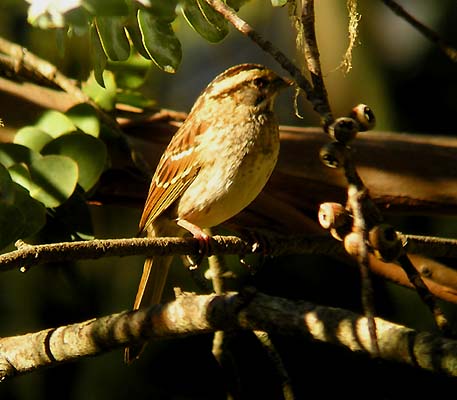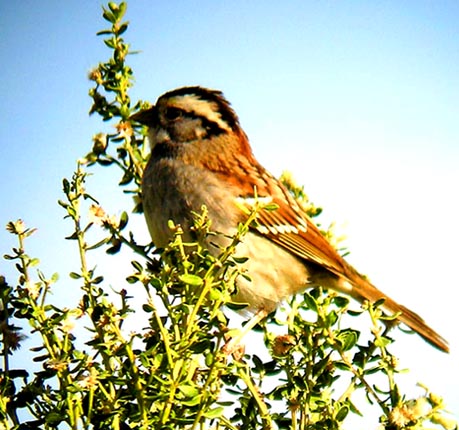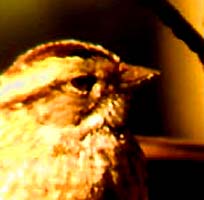|
How many White-throated Sparrows are there in MTY each year?
This is a difficult but interesting question. The Monterey Peninsula
Christmas Bird Count averages about 5 birds a year (almost all at feeders)
but the high counts have been 12 in 1994 and 14 in 1982. It is also annual
on the Moss Landing Christmas Bird Count, with 1-4 in the MTY portion of
the count circle. It is rare, however, to have more than one White-throated
Sparrow in any single Zonotrichia flock; indeed, the high count
from any one flock is just 3 from a large flock at Pfeiffer-Big Sur State
Park on 23 Feb 1991 and 3 more in another big flock in Mission Trails Park,
Carmel, 27 Jan 1990.
I do not think that Christmas Count numbers reveal very much about the
true status of White-throated Sparrow. I have lived at the same house in
Pacific Grove for 22 years (through fall 2004) and during that period I
have had a flock of 12-20 Golden-crowned Sparrows at the backyard feeder
each winter. Over this period we've recorded six White-throated Sparrows,
but only once did it winter (stayed Nov-Apr) and was it recorded on the
CBC. All the other records have been of migrants in Oct or Nov, or in spring
from late Feb into April. [Incidentally, White-crowned Sparrow, a local
breeder just 3 blocks away, has been recorded even less often in my pine-shaded
yard.] During this same 22 years, Alan & Sheila Baldridge have had
nine White-throated Sparrows in their yard, and only 3 of them have wintered
and been recorded on a CBC. Combining our numbers together results in only
4 of 15 White-throated Sparrows in these two backyard have been wintering
birds. This means for every wintering bird there are about 3 times as many
migrants passing through these two yards.
There are dozens, maybe hundreds, of similar yards on the Monterey Peninsula.
My yard averages a White-throated Sparrow about once every 4 years; the
Baldridges average one every 2.5 years; let's say the average is one every
3 years. If there are 200 similar yards on the Peninsula with bird feeders
(and there are), and each had the probability of one every 3 years, this
would mean that something like 65 White-throated Sparrows pass through
the Peninsula each year, and the odds of being recorded on the CBC are
one-in-four, the Monterey Peninsula might expect about 16 per year on the
count. Since we have reached up to 14 in a year when feeder-counts were
well-organized, perhaps these numbers are somewhere in the ballpark.
Assuming that there are at least four other areas with similar populations
of Zonotrichia sparrows in shaded habitats [Moss Landing/Marina,
Salinas/Prunedale, upper Salinas Valley, Big Sur coast] that have the same
passage of sparrows, for a total of 5 such areas, that would mean that
something
like 325 White-throated Sparrows pass through Monterey County each year,
with perhaps 80 birds wintering locally. These rough statistics suggest
that only about 10% of MTY's White-throated Sparrows are discovered
by birders each year, and I feel this is likely a fair guess. If anything,
even more sparrows are passing through than this rough 'guesstimate' suggests. |


